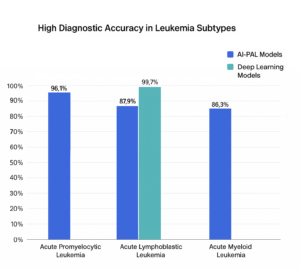Introduction
Accurate and timely diagnosis of leukemia—a group of life-threatening blood cancers—remains a critical factor in determining effective treatment outcomes. However, traditional diagnostic methods, heavily reliant on expert interpretation of microscopic images and laboratory results, are susceptible to human error and significant inter-observer variability. With recent advances in artificial intelligence (AI), particularly in machine learning and deep learning, healthcare is witnessing a transformation in diagnostic capabilities. AI-powered tools offer not only enhanced accuracy but also consistency and speed in interpreting complex clinical data. This article explores how AI is revolutionizing leukemia diagnostics, focusing on its role in reducing human error and ensuring more reliable and standardized interpretations across clinical settings.
- High Diagnostic Accuracy in Leukemia Subtypes
Recent studies have demonstrated the impressive capabilities of AI models in diagnosing various leukemia subtypes:
- AI-PAL Model: Developed in France, the AI-PAL model achieved an accuracy of 96.1% for Acute Promyelocytic Leukemia (APL), 87.9% for Acute Lymphoblastic Leukemia (ALL), and 86.3% for Acute Myeloid Leukemia (AML) using routine laboratory parameters.
- Deep Learning Models: Leveraging sophisticated architectures such as YOLOv8 and YOLOv11, researchers reported diagnostic accuracy rates as high as 99.7% for ALL detection, showcasing the tremendous potential of deep learning in early and precise leukemia diagnosis.
- Reduction in Inter-Observer Variability
AI’s ability to standardize interpretations plays a crucial role in minimizing discrepancies among different observers:
- Automated Image Analysis: AI algorithms can consistently analyze blood and bone marrow smears, reducing the subjectivity inherent in manual evaluations by pathologists.
- Consistent Performance: Multiple studies have shown that AI models maintain high diagnostic accuracy across various datasets, ensuring uniform and objective results regardless of who is interpreting the data.
- Real-Time Diagnostic Support
AI integration facilitates timely decision-making in clinical settings:
- Instantaneous Analysis: AI systems are capable of processing diagnostic images and laboratory data in real time, offering immediate insights that are vital for initiating prompt and targeted treatment.
- Clinical Decision Support: When integrated into clinical workflows, AI tools assist healthcare professionals in making informed, data-driven decisions, ultimately improving the efficiency and quality of leukemia care.
- Challenges and Considerations
Despite the promising advancements, several challenges remain before AI can be fully embedded in everyday clinical practice:
- Data Quality and Standardization: The performance of AI models is highly dependent on the quality, diversity, and consistency of training datasets.
- Integration into Clinical Practice: For seamless adoption, AI tools must be compatible with existing Electronic Health Records (EHRs) and diagnostic systems, requiring thoughtful planning and investment.
- Ethical and Regulatory Issues: The development and deployment of AI in healthcare must adhere to ethical guidelines, ensure patient data privacy, and comply with regulatory standards to gain trust and widespread acceptance.
AI has shown significant promise in enhancing the accuracy, consistency, and speed of leukemia diagnostics, thus playing a key role in reducing human error and inter-observer variability. As we move toward a future of AI-assisted healthcare, overcoming challenges related to data quality, clinical integration, and regulatory compliance will be essential. With continued research and collaboration between clinicians, scientists, and technologists, AI can help redefine leukemia diagnosis—making it faster, more reliable, and accessible to all.



Leave a Reply